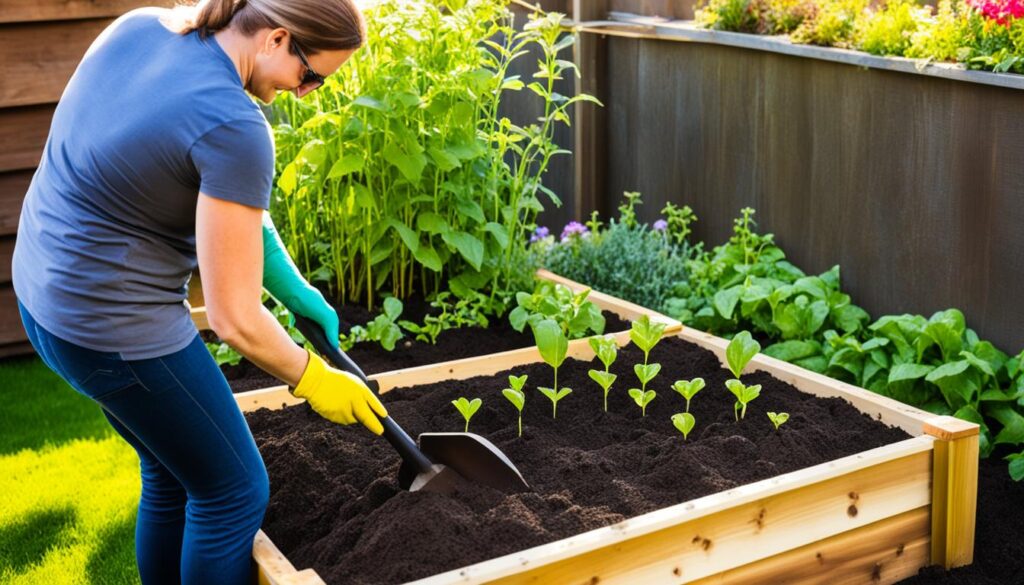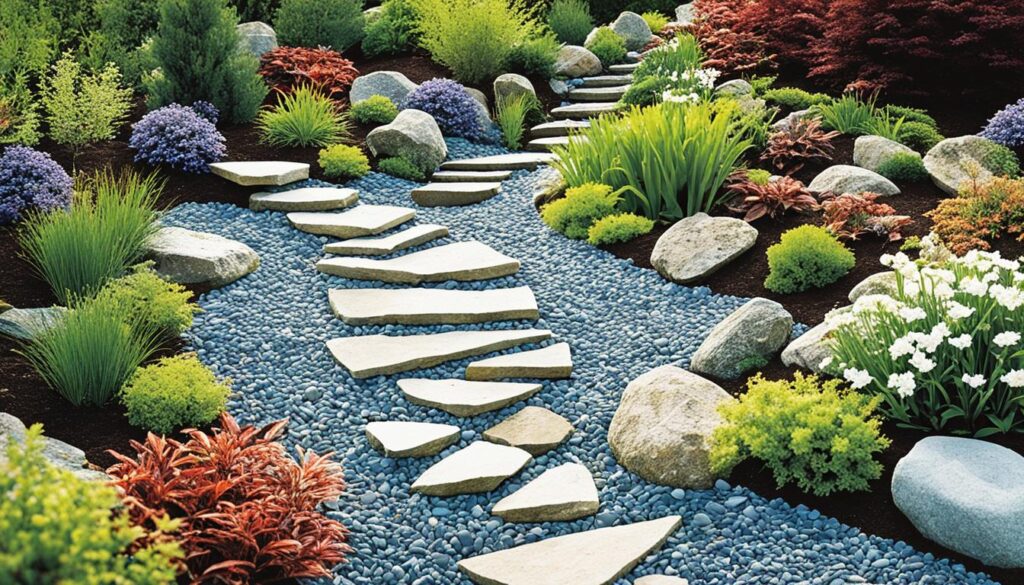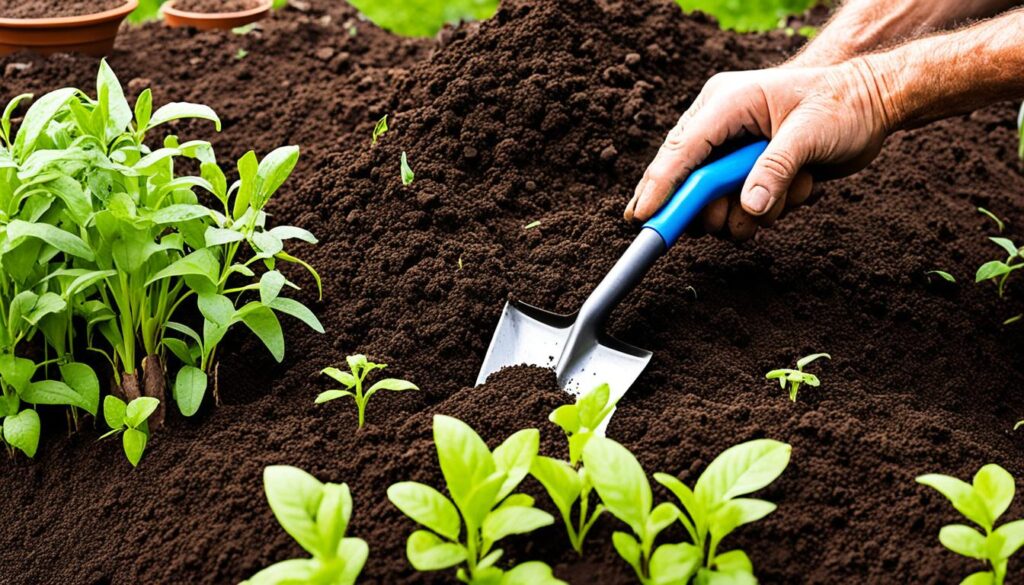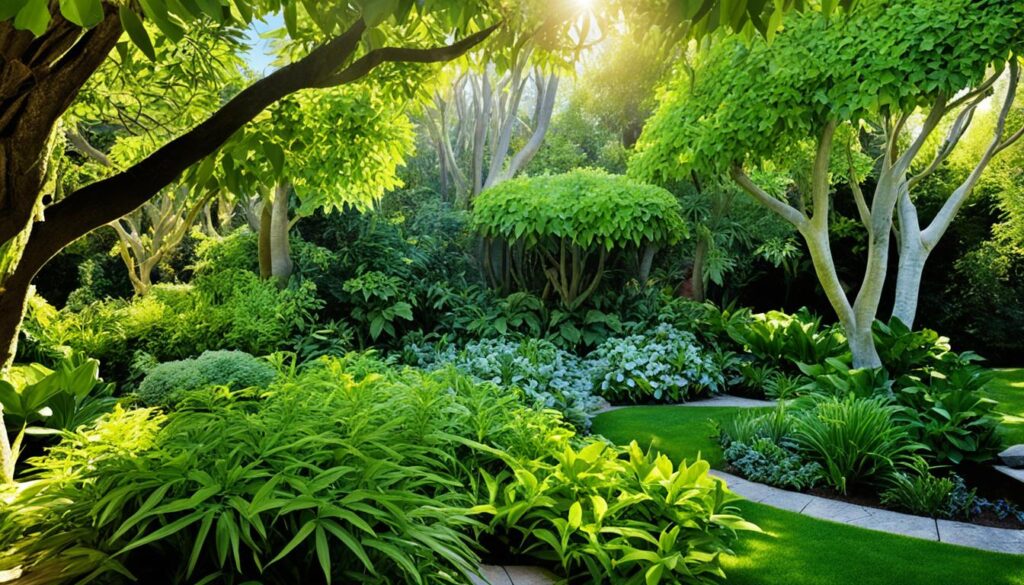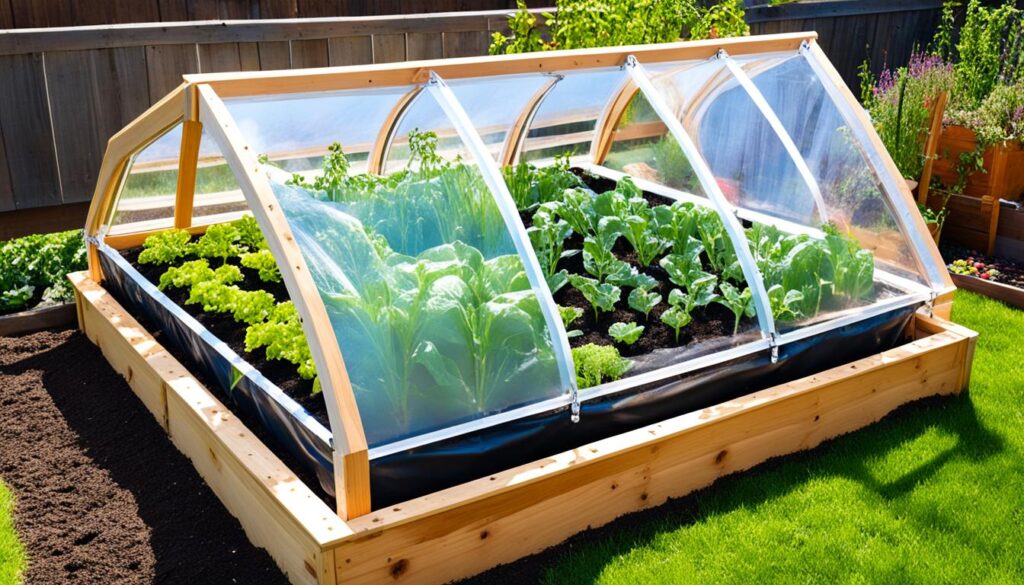Hello, garden enthusiasts! Today, I want to talk about one of my favorite plant types: herbaceous perennials. If you’re wondering what exactly a herbaceous perennial is, let me fill you in.
Herbaceous perennials are plants with non-woody stems that reach their full height and produce flowers within one year. These amazing plants have the ability to die back over the winter and reappear in all their glory the following spring, ready for another blooming season. Unlike annuals, herbaceous perennials live for more than two years, which makes them a fantastic option for creating long-lasting, sustainable gardens.
Now that you have a clear definition of herbaceous perennials, let’s dive deeper into their characteristics, how to identify them, and the best ways to care for them. So, grab your gardening gloves and let’s get started!
Key Takeaways:
- Herbaceous perennials have non-woody stems and live for more than two years.
- They die back over the winter and reappear in spring, ready for another blooming season.
- Herbaceous perennials come in various heights and can thrive in different conditions.
- These plants offer a wide range of flower colors and bloom in different seasons.
- Caring for herbaceous perennials involves providing proper growing conditions, regular watering, mulching, pruning, and fertilizing.
Characteristics of Herbaceous Perennials
Herbaceous perennials have distinct traits that make them popular in gardens. These plants come in various heights, ranging from small to large, allowing gardeners to create dynamic and varied landscapes. Whether you have a sunny spot, a shady corner, or a partially shaded area, herbaceous perennials can thrive in different situations. They are versatile and adaptable, adding beauty to any garden.
The flowers of herbaceous perennials are a delightful sight, offering a wide range of colors to choose from. You can find vibrant reds, calming blues, refreshing greens, cheerful yellows, energetic oranges, romantic pinks, regal purples, and timeless whites. With such diversity, herbaceous perennials can create stunning visual displays throughout the seasons. Whether you prefer a monochromatic palette or an explosion of vibrant hues, these plants can cater to your aesthetic preferences.
One of the remarkable characteristics of herbaceous perennials is their ability to adapt to different soil types. Whether you have fertile soil, moisture-retentive soil, reasonably drained soil, or well-drained soil, there are herbaceous perennials that can thrive in your garden. Their adaptability to diverse soil conditions makes them a versatile choice for various gardeners, regardless of the soil composition in their area.
Herbaceous perennials also offer the advantage of blooming in different seasons. While many of these plants bloom in spring and summer, some varieties extend their flowering period into autumn and even winter. This extended blooming season ensures that you can enjoy a cascade of colors and fragrances all year round, bringing life and vibrancy to your garden even during the colder months.
Overall, herbaceous perennials are characterized by their diverse heights, adaptability to different light conditions, a wide range of flower colors, ability to adapt to various soil types, and their multi-seasonal blooming. These characteristics make them a versatile and attractive choice for gardens of all sizes and styles.
Herbaceous Perennial vs Annual
When it comes to choosing plants for your garden, understanding the difference between herbaceous perennials and annuals is crucial. Herbaceous perennials and annuals have distinct characteristics that influence their lifespan and maintenance requirements.
Herbaceous perennials, as the name suggests, live for more than two years. These plants have non-woody stems and die back to the ground in winter. However, they bounce back in the spring, ready to bloom again. This makes herbaceous perennials a sustainable and long-lasting option for gardeners.
On the other hand, annuals complete their life cycle within a year. They grow from seed, produce flowers, and then die. This means annuals need to be replanted every year to maintain a vibrant garden.

Choosing between herbaceous perennials and annuals depends on your gardening preferences and goals. If you want a low-maintenance garden with plants that come back year after year, herbaceous perennials are the way to go. They provide a sense of permanence and continuity. However, if you enjoy changing up the look of your garden each year or experimenting with different plants, annuals offer versatility and a chance to explore new varieties.
Here’s a table summarizing the key differences between herbaceous perennials and annuals:
| Herbaceous Perennials | Annuals |
|---|---|
| Live for more than two years | Complete their life cycle within a year |
| Dies back to the ground in winter | Needs to be replanted each year |
| Provides a sense of continuity | Offers versatility and experimentation |
By understanding the differences between herbaceous perennials and annuals, you can make informed decisions about which plants to include in your garden. Whether you opt for the long-lasting beauty of herbaceous perennials or the ever-changing display of annuals, both options have their own unique charm and benefits.
Herbaceous Perennial Flowers
When it comes to herbaceous perennials, their flowers truly steal the show. These plants offer a magnificent array of colors, shapes, and sizes, filling gardens with vibrant splendor. Whether you’re looking for delicate blooms or bold and dramatic displays, there’s a herbaceous perennial flower to suit every taste and style.
Let me introduce you to some popular herbaceous perennial flowers:
- Poppies: With their papery petals and striking hues of red, orange, and pink, poppies add a touch of whimsy to any garden.
- Yarrow: Known for their lacy foliage and clusters of tiny flowers, yarrow blooms in shades of yellow, white, and pink, attracting pollinators to your garden.
- Achillea: Also known as yarrow, achillea flowers in vibrant shades, from deep reds and oranges to soft pinks and whites, making it a versatile choice for any garden.
- Actaea: With its unique spiky flowers and dark foliage, actaea, or bugbane, creates a striking contrast in shady areas of the garden.
- Fuchsia: Loved for their elegant, pendulous flowers, fuchsias come in a variety of colors, including shades of red, pink, purple, and white, adding a touch of grace to hanging baskets or containers.
These herbaceous perennial flowers can be used in various garden settings. They make wonderful additions to mixed borders, where they can mingle with other perennial plants, creating a harmonious blend of textures and colors. Additionally, herbaceous perennials can be planted as focal points in the garden, drawing attention and providing a captivating centerpiece.
“The flowers of herbaceous perennials come in a variety of shapes, sizes, and colors, adding a splash of color to gardens and can be used in mixed borders or as focal points in the garden.”

As you can see, the beauty of herbaceous perennial flowers is truly captivating. Their blooms add depth, texture, and visual interest to any garden. Whether you’re a fan of bold and vibrant colors or prefer delicate and subtle shades, the world of herbaceous perennial flowers offers endless possibilities for creating a stunning garden display.
How to Identify Herbaceous Perennials
Identifying herbaceous perennials is a fascinating endeavor that allows us to appreciate their distinct characteristics. These remarkable plants have non-woody stems that gracefully retreat during winter and emerge anew with vibrant life in the spring. To recognize herbaceous perennials, we can rely on various visual cues and botanical features that set them apart.
Growth Habit and Above-Ground Appearance
The first step in identifying herbaceous perennials is to observe their growth habit and above-ground appearance. Unlike woody plants, these perennials exhibit a delicate, non-woody stem structure that is often herbaceous in nature. As winter approaches, these stems die back, wither, and disappear, only to rejuvenate again in the spring. By familiarizing ourselves with this life cycle pattern, we can easily identify herbaceous perennials.
Another distinguishing feature is the foliage. Herbaceous perennials boast an array of leaf shapes, from lobed and palmate to lance-like and ovate. The leaves can be arranged alternately or opposite each other along the stem. Flowering herbaceous perennials also exhibit different flower forms, such as clusters, spikes, umbels, and panicles.
Below-Ground Structures
Delving beneath the surface, we discover unique below-ground structures that contribute to the survival of herbaceous perennials. Many of these plants possess specialized organs, such as tubers, bulbs, crowns, or underground stems, which allow them to endure the dormant winter period. These structures store nutrients and energy, enabling the perennial to regenerate and flourish in the following growing season. By carefully examining the root system and underground structures, we can identify herbaceous perennials with confidence.
Useful Techniques for Identification
To identify herbaceous perennials more effectively, consider the following techniques:
- Consult botanical guides or databases that provide detailed information and images of various herbaceous perennials.
- Observe the plant’s overall height and growth habit, noting whether it forms clumps or spreads through rhizomes or runners.
- Examine the flowers and inflorescences, paying attention to their shape, size, color, and arrangement.
- Take note of the plant’s preferred growing conditions, including soil type, sun exposure, and moisture requirements.
By utilizing these techniques, plant enthusiasts can confidently identify herbaceous perennials and appreciate their remarkable resilience and beauty.

The distinct characteristics of herbaceous perennials, from their non-woody stems to their below-ground structures, provide valuable clues for identification. By familiarizing ourselves with these features and employing useful techniques, we can unlock the secrets of these stunning plants and marvel at the wonders of nature.
Herbaceous Perennial Care
Taking care of herbaceous perennials is vital to ensure their health and longevity. By providing the right growing conditions and following a few simple steps, you can help your herbaceous perennials thrive and flourish year after year.
1. Well-drained Soil and Regular Watering
Herbaceous perennials require well-drained soil to prevent waterlogged roots that can lead to root rot. Ensure that the soil drains properly and doesn’t hold excess moisture.
During dry periods, it’s essential to water your herbaceous perennials regularly. Deep watering once or twice a week is generally sufficient, depending on the specific needs of each plant. Monitor the soil moisture level and adjust the watering schedule accordingly.
2. Mulching for Moisture Retention and Weed Control
Mulching around your herbaceous perennials provides multiple benefits. It helps retain moisture in the soil, preventing excessive evaporation, and reduces weed growth by inhibiting weed seeds from germinating.
Apply a layer of organic mulch, such as shredded bark or compost, around the base of the plants. Keep the mulch a few inches thick, ensuring it doesn’t touch the stems, which could cause rotting. Replenish the mulch annually to maintain its effectiveness.
3. Pruning and Deadheading for Continuous Blooming
To promote continuous blooming and maintain a tidy appearance, it’s important to prune and deadhead spent flowers from your herbaceous perennials. Trim back faded blooms to encourage the production of new flowers.
You can also prune herbaceous perennials in early spring to remove any damaged or overgrown sections. This allows for healthier growth and better flowering during the upcoming season.
4. Staking for Support
Some herbaceous perennials, particularly taller varieties, may require additional support to prevent their stems from bending or breaking. Staking is an effective way to provide this support.
When staking, use bamboo poles or other sturdy materials and gently tie the stems to the stakes using soft ties or twine. This will help keep the plants upright and prevent damage caused by heavy rain or strong winds.
5. Regular Fertilizing and Division
Regular fertilizing ensures that your herbaceous perennials receive the necessary nutrients for healthy growth and vibrant blooms. Use a balanced fertilizer, following the recommended dosage on the product label. Apply fertilizer in early spring and again midway through the growing season.
As herbaceous perennials mature, they may become overcrowded or spread out too much. Dividing these plants every few years rejuvenates them, encourages robust growth, and enhances flowering. Spring or autumn is the best time to divide herbaceous perennials when the soil is moist and the plants are not actively blooming.
Remember to water the newly divided plants thoroughly after replanting them to help them establish quickly.
Follow these essential care practices to ensure the health, beauty, and longevity of your herbaceous perennials. With the right care, these plants will reward you with stunning blooms and a vibrant garden year after year.
Best Herbaceous Perennials for Gardens
When it comes to choosing the best herbaceous perennials for your garden, there are a variety of options that can bring charm and beauty to your outdoor space. Consider adding some of these popular choices to create stunning displays of vibrant colors and textures:
1. Delphinium
Delphiniums are tall, majestic plants that produce stunning spikes of flowers in shades of blue, purple, pink, and white. They can add vertical interest to your garden and attract butterflies and bees.
2. Lupines
Lupines are known for their tall spires of vibrant blossoms that come in shades of pink, purple, blue, and yellow. These plants are a great addition to cottage-style gardens and attract pollinators.
3. Peonies
Peonies are beloved for their large, fragrant blooms that come in a range of colors, including pink, white, red, and yellow. These long-lived perennials are often used as cut flowers and can create an elegant focal point in any garden.
4. Ornamental Poppies
Ornamental poppies are striking plants that feature large, showy flowers in shades of red, orange, pink, and white. They can add a bold, dramatic element to your garden and attract bees and butterflies.
5. Yarrow
Yarrow is a versatile perennial that produces clusters of small, flat-topped flowers in various shades of yellow, pink, and white. It is known for its feathery foliage and is often used in dried flower arrangements.
6. Achillea
Achillea, also known as yarrow, is a low-maintenance perennial with feathery foliage and flat-topped flower clusters. It comes in a range of colors, including shades of pink, red, yellow, and white. Achillea is drought-tolerant and attracts butterflies.
7. Actaea
Actaea, also known as bugbane, is a shade-loving perennial that produces tall spires of fragrant white or pink flowers. It is an excellent choice for adding interest to shady areas of your garden.
8. Fuchsia
Fuchsias are known for their pendulous, bell-shaped flowers that come in various color combinations, including shades of pink, purple, and red. They are a popular choice for hanging baskets and containers.
These herbaceous perennials are just a few examples of the many options available to enhance your garden. Experiment with different combinations, heights, and bloom times to create a beautiful and diverse landscape.
| Plant | Color | Height | Bloom Time |
|---|---|---|---|
| Delphinium | Blue, purple, pink, white | Tall | Summer |
| Lupines | Pink, purple, blue, yellow | Tall | Summer |
| Peonies | Pink, white, red, yellow | Medium to tall | Spring |
| Ornamental Poppies | Red, orange, pink, white | Tall | Summer |
| Yarrow | Yellow, pink, white | Medium | Summer |
| Achillea | Pink, red, yellow, white | Short to medium | Summer |
| Actaea | White, pink | Tall | Summer |
| Fuchsia | Pink, purple, red | Medium to tall | Summer to fall |
Buying Perennials
When it comes to purchasing perennials for your garden, there are a few key considerations to keep in mind. Buying mature plants that come in larger containers, such as 9 cm or bigger, is advisable. These well-established perennials have already developed a strong root system and are more likely to establish quickly in your garden, providing you with beautiful flowers right from the beginning.
One reputable supplier that offers a wide range of perennials for gardeners to choose from is Jackson’s Nurseries. With their extensive selection, you’ll be able to find the perfect perennials to enhance your garden and create a stunning display of colors and textures.
By choosing mature perennials and purchasing them from a trusted supplier like Jackson’s Nurseries, you can ensure that your garden will flourish with vibrant blooms year after year.
Conclusion
Herbaceous perennials are an excellent choice for gardens, offering the perfect combination of longevity, stunning flowers, and adaptability. These plants can live for more than two years, providing continuous beauty year after year. By understanding the characteristics of herbaceous perennials, identifying them accurately, and providing proper care, gardeners can create a vibrant and ever-changing outdoor space.
When selecting herbaceous perennials for your garden, consider their unique features and suitability for your specific growing conditions. With their wide range of colors and textures, these plants can transform any garden into a picturesque oasis. Whether you prefer delphiniums, lupines, peonies, or ornamental poppies, there is a herbaceous perennial that will catch your eye.
Ensure the success of your herbaceous perennials by providing them with well-drained soil, regular watering, and appropriate pruning. To maintain their health and longevity, enlist the help of mulch to retain moisture and suppress weeds. Dividing the plants when necessary and providing support through staking will ensure they continue to flourish season after season.
So, embrace the beauty and charm of herbaceous perennials in your garden. With their enduring nature, vibrant blooms, and ability to adapt to various conditions, these plants are sure to bring joy and visual interest to your outdoor space for years to come. Happy gardening!

